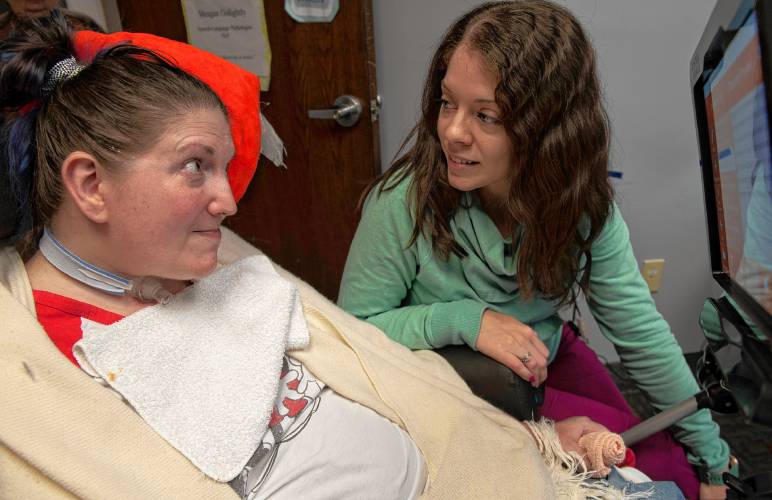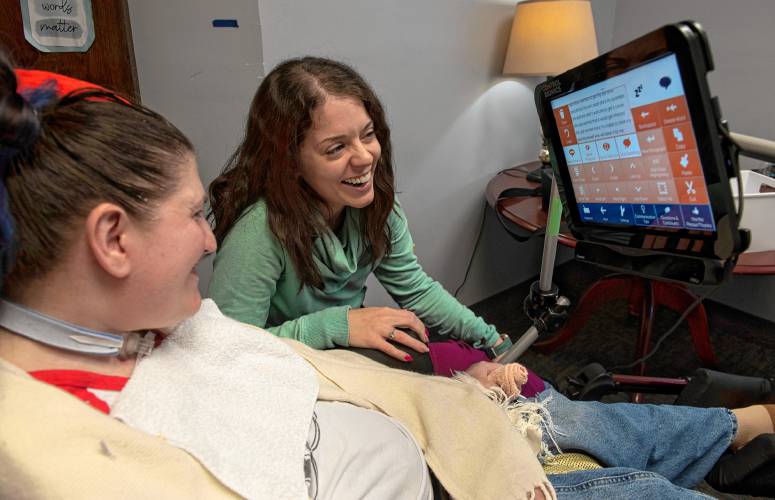Helping people past brain injury barriers: Strive Clinic trains people with assistive technologies
| Published: 10-17-2023 6:01 PM |
HOLYOKE — Mel Hearne sustained a spinal cord injury in 2004 that left her paralyzed and unable to speak. For 17 years, she answered yes or no questions by raising her eyebrows for “yes,” and rolling her eyes back and forth for “no.”
Today she “speaks” in complete sentences with the help of an eye gaze device, which tracks her eye movements across the image of a QWERTY keyboard — which refers to the first six letters on the upper row of the keyboard — and converts what she spells into speech.
In this manner of speaking, Hearne has her voice back.
Hearne is one of dozens of clients at the Strive Clinic, a subdivision of local health care agency ServiceNet that offers physical, occupational and speech therapy to people with brain injuries.
“Our goal is to make sure that people keep getting treatment so that they’re able to maintain that maximum level of independence,” said Director of Operations Ellen Werner, who helped launch the clinic at the beginning of the pandemic.
Most of their clients have been injured for at least five years, speech therapist Meagan Golighty said, and making a full recovery is not in the cards.
“Your brain’s got maybe a good two years of push, push, push — pushing recovery,” Golighty said, before a client’s condition plateaus. “[Then] your brain just kind of stays, and we’re maintaining the skills that we have now because we don’t need to lose them.”
Golighty asks clients which skills they want to develop and works toward those goals during appointments so they feel motivated to return, which can be challenging for people with brain injuries.
Article continues after...
Yesterday's Most Read Articles
“What you find most often with someone with a brain injury ... they lose that ability to initiate activities, and they lose that basic motivation to do things,” Werner said. “You have to make them want to come here, so I think the staff here do a really good job of keeping things really positive and fun.”
Staying positive means not shying away from clients’ injuries, Golighty said. Many of her clients become visibly agitated when she mentions the car accident, stroke or other trauma that caused their injury, but acknowledging what happened can accelerate recovery.
“You have to imagine your entire world’s just getting flipped upside down, and that’s what it is for them, and I think some clients have a harder time accepting that,” Golighty said. “We find with a lot of our clients who have accepted what has happened to them and use it as a motivational stepping stone, there’s been so much more progress.”
The clinic serves people who are covered by the Acquired Brain Injury and Moving Forward Plan waiver program, which provides skill training and personal assistance to people with brain injuries returning to independent living after staying in a long-term care facility. ABI/MFP waiver recipients must be living in a nursing home for at least 90 days at the time they apply to the program — shutting out those who have already moved out of a facility but need support.
“I would get phone calls from people saying, ‘Hey, so-and-so had an injury 15 years ago, and they’re just sitting at home all day with nothing to do. Can you help?’ And it’s like, unfortunately, there’s no way to get you into that program,” Werner said. “It’s sad because you have to tell people sorry, I can’t help you.”
In August, the Massachusetts Department of Developmental Services awarded the clinic with a contract of up to $200,000 per year to fund the purchase of assistive technologies for people with intellectual and developmental disabilities. Therapists will now be able to expand their clientele beyond people with brain injuries, requiring a new approach to how they help people perform physical activity and communicate.
“Folks with brain injuries, they’ve learned all the skills already during their lifetime, so it’s just getting them back to doing those things again,” Werner said. “Whereas someone with a developmental disability may not have ever learned those skills.”
Strive Clinic therapists will visit the home or day program of people with disabilities and assess which technologies the person could benefit from, just how they would match a client with a brain injury to a piece of assistive technology.
“You always want to start with evaluating,” Golighty said. “You need to be able to get baseline of what they’re doing right now, what their goals are and then what their interests are so you can use that as motivation.”
Assistive technology can range from a mouth guard that automatically brushes clients’ teeth to a smart oven that analyzes what they are cooking and when it is finished. The state is interested in any device that lowers people’s dependence on staff at long-term care facilities, Werner said.
“That really became apparent in COVID when the staffing was really hard to get, and it’s still really hard right now,” she said.
The clinic is currently serving four people under the DDS grant, in addition to more than 40 clients with brain injuries. Whether they have a developmental disability or brain injury, there is no one-size-fits-all rule for how therapists at the clinic approach their clients.
“Every brain is different, so I think you have to go into any situation knowing this person is different from the last person you met,” Golighty said. “We’re all different.”





 Southampton takes key step toward new public safety complex following TM vote
Southampton takes key step toward new public safety complex following TM vote State OKs Valley Green Energy program for Amherst, Northampton, Pelham
State OKs Valley Green Energy program for Amherst, Northampton, Pelham Southampton Town Meeting adopts noise nuisance bylaw, rejects unregistered vehicle rules
Southampton Town Meeting adopts noise nuisance bylaw, rejects unregistered vehicle rules ‘Working towards peace’: Lander-Grinspoon Academy engages kids in learning about conflict, peace activism
‘Working towards peace’: Lander-Grinspoon Academy engages kids in learning about conflict, peace activism
